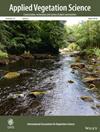Ecosystem services provided by semi-natural and intensified grasslands: Synergies, trade-offs and linkages to plant traits and functional richness
Abstract
Question
Semi-natural grasslands (SNG) are important for maintaining biodiversity and ecological processes in farmland. Current pasture-based livestock production mainly occurs on intensified grasslands (IG) that have been agronomically improved. Although it is documented that SNG and IG differ in terms of plant diversity, their ability to provide ecosystem services (ES) in farmland is less explored. Here, we review the role of SNG and IG in delivering ES, illustrate their trade-offs and synergies, and examine how ES can be assessed by using plant traits and functional richness.
Results
We found that SNG generate a wider range of ES than IG. Trade-offs exist between ES that appear more pronounced in IG between high biomass production and other ES. SNG are good in providing habitat for biodiversity, supporting pollination and cultural services. SNG also have a significantly wider range of plant functional traits and a higher functional richness, suggesting that the potential to supply ES in SNG is partly driven by higher number of species and their functional diversity.
Conclusion
Clearer trade-offs were found in IG compared with SNG, supported both by the literature and the functional richness. This suggests that functional knowledge could be a good complement to understand the mechanisms behind ES generation and could help with tailoring grassland management to sustain biodiversity, ecological functions and ES. Although both IG and SNG are likely needed for the long-term sustainability of food production, both could aim for a more balanced generation of ES, increasing biodiversity and functional redundancy at the landscape scale.


 求助内容:
求助内容: 应助结果提醒方式:
应助结果提醒方式:


